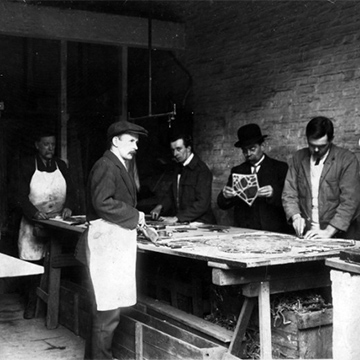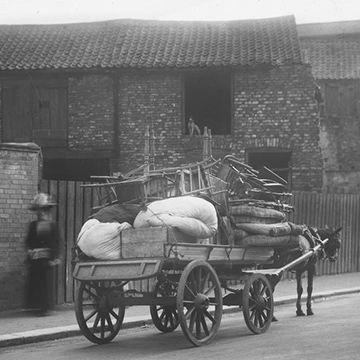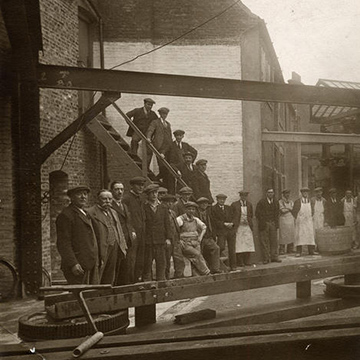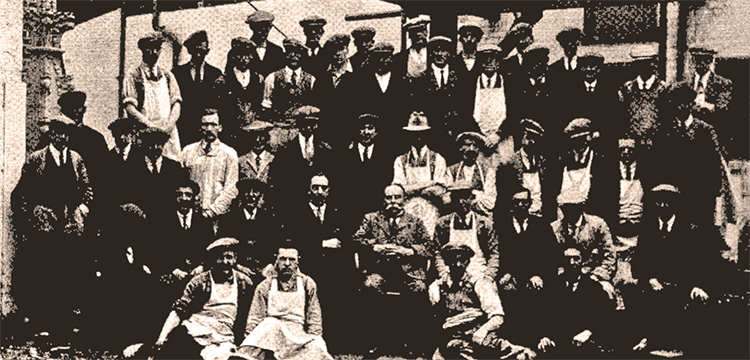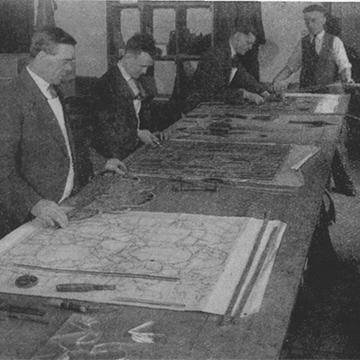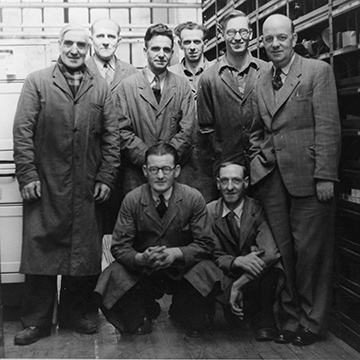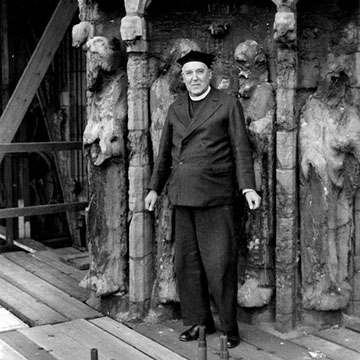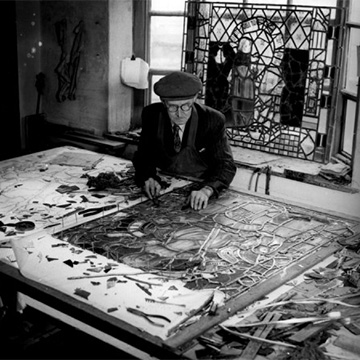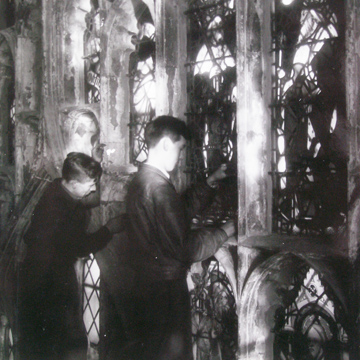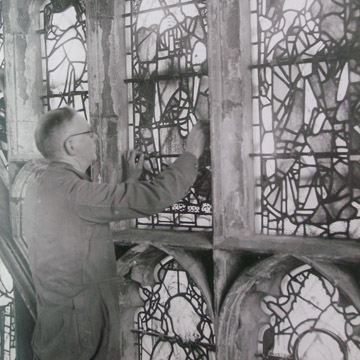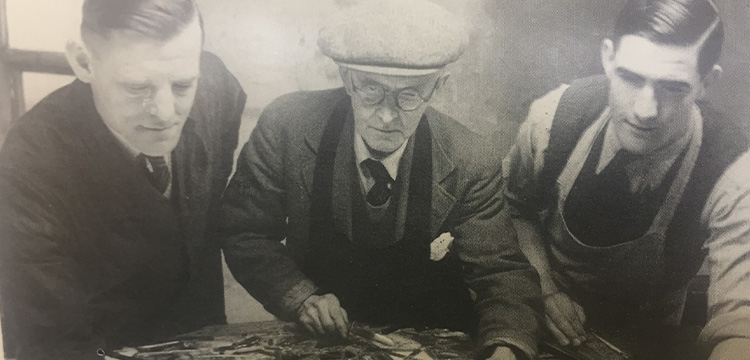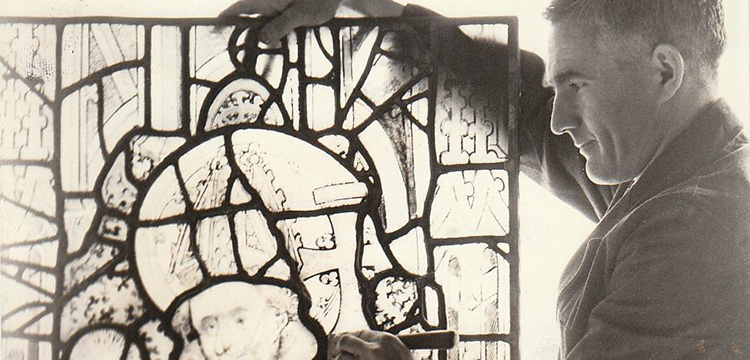
Our Story
Over 50 Years of Excellence in Stained Glass Craft and Conservation
More than half a century ago the York Glaziers Trust was formed, building on centuries of craftsmanship associated with York Minster, Britain's treasure-house of stained glass. The Trust is an independent charitable trust dedicated to the care of the Minster's windows and the preservation of historic stained glass nationwide - the vision of Eric Milner-White (1884-1963), Dean of York from 1941 until his death in 1963.
Restoration of the Minster's stained glass had historically been undertaken by a variety of external contractors, some of whom were local plumber/glaziers and some who were stained glass artists of significant repute. From the 1400s the Petty family can be associated with the Minster, and from the 1500s the Thompson family. One of the most famous seventeenth-century glass artists, Henry Gyles (1645-1709), as well as his father Edmund (1611-76), were paid for repairs to the stained glass during the mid-1600s. Further repairs were made in the 1600s by Marmaduke, Edward, and Charles Crosby, who were also responsible for some of the glazed armorial shields at Temple Newsam, Leeds. In the eighteenth-century, leading Georgian craftsman William Peckitt (1731-95) worked on the Minster's windows. During the nineteenth-century, restoration of York Minster's stained glass has been undertaken by firms such as Newcastle-based William Wailes (1808-1881), and London-based Burlison and Grylls (formed by John Burlison (1843-1891) and Thomas Grylls (1845-1913)).
As well as studios from far afield, during this period a multiplicity of other firms, who all operated from premises within metres of the Minster, also carried out work to the Minster's windows. For example, during the 1840s and 50s, York Minster's accounts show that Thomas and William Noton were frequently called upon to make repairs to the Minster's stained glass. Thomas had a studio on Stonegate, while William had his workshop at 19 Little Stonegate, just around the corner. At the same time, in the 1840s, John Joseph Barnett (1786-1859) was responsible for work to windows in the chapter house and nave. Barnett and Son were first established as glass-cutters and opticians at College Street, adjacent to the Minster, and then later as journeymen plumber/glaziers based at master builder Henry Bowman's yard at Jewbury, in Monkgate. By 1847 the business had moved to larger premises at 16 St Andrewgate. Contemporary accounts attribute John Barnett as having been a stained glass pioneer who conducted tireless experiments in order to recapture knowledge (long since lost) of vitreous enamel paint recipes. Alongiside his work in the York area, windows by his hand furnished the chapel at Queen's College, Cambridge, in the 1840s and 50s. From the 1840s Barnett advertised his studio as: 'The York Cathedral Glassworks, John Barnett and Son, Stained Glass Manufacturers and Restorers to the Dean and Chapter of York' (F. Llewellynn, Royal Agriculture Society Handbook, 1848, p. 8). When John's sons Francis and Mark took over the business in the 1850s and relocated to Leith in Scotland, the company's association with the Minster apparently persisted, as they continued to advertise themselves as glass stainers to the Dean and Chapter of York.
Another company who feature in the Minster's records is T & W Hodgson of York, formed by Thomas (b.1813) and William Hodgson. From at least the 1850s, the business operated from workshops at 25 Stonegate, York, when census documents show that the Hodgsons employed three men and two boys. The two apprentices, one of which was his young cousin, lived and worked in the building with their employer. By the 1861 census, Hodgson's business had gone from strength to strength. By this time he employed 15 men and 4 boys. On the death of Thomas Hodgson, in the 1880s, the business passed to his eldest son Thomas Gerard Hodgson, who carried it on until 1923. Alongside their glazing work, the firm also manufactured and installed lead sanitation pipes, and were therefore plumber/glaziers adept with working with a variety of leaded products. The firm was also responsible for installing and restoring windows by the celebrated Belgian stained glass artist Jean-Baptiste Capronnier (1814-1891). During this period, Hodgson's employed Mark Barnett, John Joseph Barnett's son, and former employee of the Newcastle-based workshop of William Wailes.
From the 1880s, York-based John Ward Knowles (1838-1931), is also recorded to have worked for the Minster. As a young man, in 1858 Knowles received some initial brief training in central London at the relatively recently formed workshops of leading Victorian studio Heaton and Butler (formed by the Warwickshire-born duo of Clement Heaton (1824-1882) and James Butler (1830-1913)), before returning to York and establishing his own studio on Goodramgate. By 1869 Knowles had a home/studio at 41 Stonegate, before moving to 35 Stonegate (now 23), which would be the Knowles studio premises for the proceeding 120 years. At the same time as Knowles, Joseph Robinson (b.1825) of 6 Little Stonegate was responsible for remedial work to the Minster's stained glass. At this time Robinson's was the slightly larger of the studios in terms of its staff, employing 6 men and 3 three boys, while Knowles employed just 4 men and a boy. However, it is the Knowles firm that is widely understood to be associated with excellence in stained glass scholarship and craftsmanship.
From the early 1900s, for the first time, the care of the Minster's stained glass had been entrusted to a single, private stained glass workshop operated by the Dean and Chapter. The buildings on Deangate, which house the Minster's Works Department, were constructed from 1913 and this would become the glaziers' home from then on. Building work on the Deangate premises began following the demolition of a set of stables where the horses used to pull mourning hearses had once occupied. At this time the Minster's precinct was enclosed by a 12ft high wall. One of four gated entrances to the Minster's grounds was to be found at the intersection of Deangate and Goodramgate. A re-configuration of the roads in this area of York in 1903 permitted new re-development of the land surrounding the Minster. Together with York Minster's stone masons, joiners, electricians, and other skilled craftsmen, the glaziers have continuously occupied 6 Deangate, in the shadow of the Minster, for over a century now (since 1913). Remarkably, British Pathé video footage from 1927 allows us to see some of the glaziers from this period at work in the Minster, click here for the footage.
From the 1900s to the 1930s, the Minster glaziers were said to have completed the restoration of all of the Minster's windows, as part of a continuous cycle of work supervised by Robert Charles Green (1864-1936), clerk of works at York Minster from 1895 until his death in 1936, and then by his son William Jesse Green (1896-1979). The Greens lived first at 11 Precentors Court, at the Minster's west end, before moving to 1 Deangate, opposite the cathedral's works departments, by 1911. In 1925, local newspapers reported that there were 'eight expert glaziers' working on the Minster's glass, all working from their relatively new custom-built studio on Deangate ('Visit to the Minster Workshops', Yorkshire and Leeds Intelligencer, 19 August 1925, p. 6).
TOP LEFT: The Minster's glaziers restoring the St Cuthbert window, 1935; TOP RIGHT: The Minster Glazier's, c.1940; MID LEFT: Dean Milner White, c.1950; MID RIGHT: Herbert Nowland, c.1950; BOTTOM LEFT: The Minster Glaziers, c.1950; BOTTOM RIGHT: The Minster Glazier's, c.1950; images: YGT/Chapter of York
Following World War Two, the Minster glaziers were led by their foreman 'Bob' Oswald Ernest Lazenby (1904-1983), who was born in Knaresborough near Harrogate. He was part of a select team of three that included Herbert Nowland (1880-1972) of Temple Newsam, Leeds. Nowland had been a glazier since he was fourteen years old, but first reported for work at the Deangate workshop during wartime - when already a pensioner - after some of the original glazing team had been conscripted to fight. Following the war, he stayed on at the Trust, and was the principal glazier associated with the restoration of the Great East Window in the 1940s; Lazenby was said to have assisted only on the more complex panels. Nowland retired in 1955, after celebrating his 75th birthday, and Lazenby in 1968.
80 of the Minster's windows were removed for safety during World War Two. Subsequently, it was Dean Milner-White who directed and chronicled the restoration and reinstallation of these windows in the aftermath of the Second World War. Milner-White supported a small team of glaziers entrusted with this task, including Lazenby, Nowland and their young apprentice Peter Gibson (1929-2016), who began his training in stained glass at 16.
With the help of the Pilgrim Trust, the Dean's vision of establishing a specialist stained glass studio independent of Chapter was later made a reality. The Trust came into being on 20 July 1967 with Peter Gibson OBE as its first secretary and superintendent. By the time f his retirement, Peter had been associated with the Deangate workshop for half a century, beginning his apprenticeship there in 1945, and only retiring in 1995. Under his leadership, the Trust's expertise was put to the test in 1984 when a fire in the Minster's south transept caused terrible damage, endangering the famous rose window.
The Trust now employs an international team of 16 members of staff. As well as their original premises on Deangate, for the last decade the Trust has also operated a second workshop at Bedern Chapel, York, the former ancient home of the Minster's Vicars Choral since 1349. From 1998 to 2007 the Trust was involved in the conservation of York Minster's c.1414 St William window. Another particular highlight, from 2011 to early 2018, has been the conservation of the Great East Window (1405-08) by the glass-painter John Thornton, one of the most important and well-known stained glass craftsmen of the medieval period. From 2016, the Trust has also initiated a 20-year rolling programme of conservation and environmental protection in partnership with York Minster, beginning with the conservation of three of the Minster's world-famous fourteenth-century nave aisle windows.
Get In Touch
If you would like more information on our conservation services please get in touch.
Contact UsContact Us
The York Glaziers Trust, 6 Deangate, York, YO1 7JB

